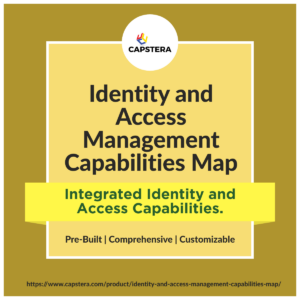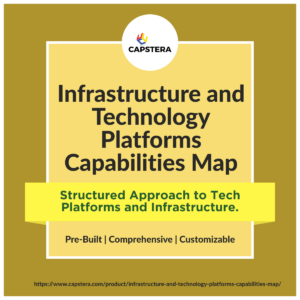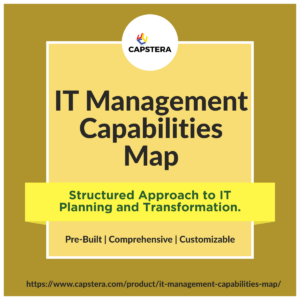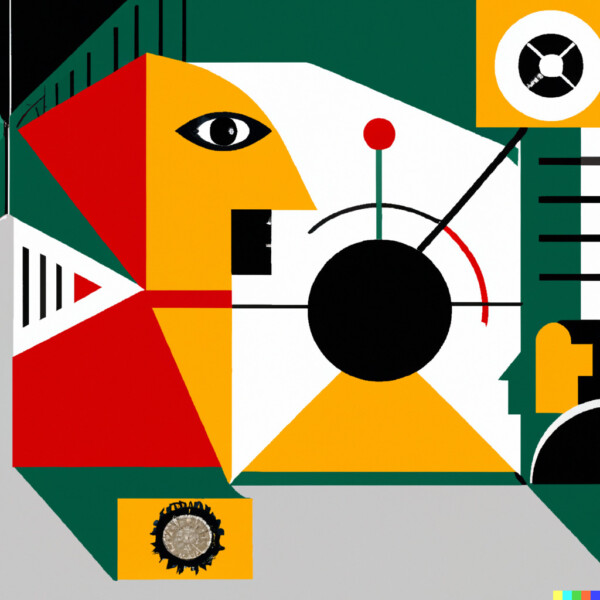
A comprehensive whitepaper on the concepts and constructs of Enterprise Information Technology Architecture.
Definition of Enterprise Information Technology Architecture (EITA) and Enterprise Architecture (EA)
Enterprise IT Architecture (EITA) is a structured approach to aligning IT strategy with business goals, focusing specifically on designing and integrating IT systems within an organization. In contrast, Enterprise Architecture (EA) is a broader concept that includes aligning business strategy with IT but also encompasses other organizational aspects like business processes, organizational structure, and strategy.
Importance of IT in Modern Enterprises
IT is pivotal in driving innovation, efficiency, and competitive advantage in today’s fast-paced business environment. The right IT strategy ensures that technology supports the business’s evolving needs, enables streamlined operations, and fosters agility. Modern IT is at the core of virtually every aspect of business operations and decision-making, from cloud computing to data analytics.
Purpose and Objectives of Enterprise Information Technology Architecture
The primary purpose of EITA is to create a cohesive and streamlined IT infrastructure that is closely aligned with the business’s strategic goals. The objectives of EITA include:
- Facilitating clear communication between IT and business stakeholders.
- Enhancing the efficiency and effectiveness of IT systems.
- Ensuring that IT investments support and drive business objectives.
- Implementing robust security measures to protect data and systems.
Focus Areas of EITA
EITA focuses on several key areas to achieve its objectives:
- Application Architecture: Designing and integrating applications to support business processes.
- Data Architecture: Structuring and managing data to enable clear insights and efficient operations.
- Technology Architecture: Selecting and implementing the right technology stack to support the overall IT strategy.
- Security Architecture: Establishing protocols and measures to safeguard information and systems.
How EITA is Different and Similar to EA
While both EITA and EA aim to align technology and business strategies, they differ in their scope and focus:
- Similarities:
-
- Both include the alignment of IT with business strategy.
- Both utilize frameworks and methodologies to guide the design and implementation process.
- Both emphasize collaboration between IT and business stakeholders.
- Differences:
-
- EITA specifically focuses on IT, whereas EA encompasses a broader range of organizational aspects.
- EITA is generally more concerned with the technical details of IT systems, whereas EA may focus more on business processes and strategy.
- EITA often requires more specialized IT knowledge, while EA may require a more comprehensive understanding of the entire organization.
Enterprise information technology architecture offers a specialized approach to IT architecture that is both aligned with and distinct from the more encompassing concept of EA. By focusing solely on IT, EITA provides a targeted framework to ensure that technology effectively supports the strategic objectives of the modern enterprise. It reflects the critical role that IT plays in today’s business landscape, highlighting the need for a coherent and well-articulated IT strategy.
Comparison of Enterprise Information Technology Architecture and Enterprise Architecture
Historical Background
The concept of Enterprise Architecture (EA) emerged during the late 1980s as organizations began to recognize the need for a strategic alignment between business and technology. It sought to integrate various aspects of the business, including organizational structure, processes, and IT.
ON THE OTHER HAND, Enterprise IT Architecture (EITA) was developed as a subset of EA with a more specialized focus. Recognizing the increasingly complex and vital role of IT within businesses, EITA emerged in the early 2000s to specifically address the alignment, design, and governance of IT systems.
Key Principles of EA
EA operates on several fundamental principles that guide the alignment of the entire organization:
- Holistic Approach: EA looks at the organization as a whole, integrating business processes, strategy, and technology.
- Strategic Alignment: It ensures that technological investments and designs align with the business’s goals and vision.
- Standardization: EA promotes using common processes and technologies to foster organizational efficiency and consistency.
- Adaptability: It emphasizes the ability to respond and adapt to changing business environments and needs.
Key Principles of Enterprise Information Technology Architecture
EITA, while sharing some principles with EA, focuses on specific aspects related to IT:
- IT Alignment: EITA ensures that IT strategies and systems align directly with business objectives.
- Technical Focus: EITA delves into the technical aspects of IT, including system design, integration, and management.
- Security and Compliance: It emphasizes robust security measures and adherence to regulatory requirements.
- IT Efficiency: EITA aims to enhance the performance and cost-effectiveness of IT operations.
Similarities and Differences between EITA and EA
- Similarities:
-
- Alignment with Business Goals: EITA and EA strives to align technology with business strategy.
- Use of Frameworks: Both utilize structured approaches and frameworks to guide the implementation process.
- Differences:
-
- Scope: While EA encompasses the entire organization, including IT, EITA specifically focuses on IT components.
- Focus: EITA emphasizes technical details and efficiency within IT, whereas EA looks at broader organizational alignment and integration.
Role of IT in Both Architectures
IT is one of the many components that must align with the overall business strategy in EA. It plays a supporting role, integrating with other aspects of the organization to achieve strategic goals.
In EITA, IT is the central focus. The architecture is built around the understanding that IT is not just a support function but a key driver of business success. EITA emphasizes IT systems’ optimization, security, and strategic alignment to enable the business to thrive in a technologically driven environment.
While EITA and EA both aim to align technology with business goals, they differ in scope, focus, and application. EA provides a comprehensive view of the entire organization, while EITA offers a specialized approach targeting IT. These distinctions reflect IT’s role in business evolution from a supportive function in EA to a central component in EITA. Understanding these differences and similarities is vital for businesses to choose the appropriate approach for their specific needs and objectives.
Benefits of Enterprise IT Architecture



 Enterprise IT Architecture (EITA) offers a range of benefits tailored to the specific needs of modern organizations that depend heavily on information technology. The following explores these benefits in detail:
Enterprise IT Architecture (EITA) offers a range of benefits tailored to the specific needs of modern organizations that depend heavily on information technology. The following explores these benefits in detail:
Alignment with Business Strategies
EITA plays a crucial role in aligning IT functions with the overall business strategies of an organization. Focusing on clear communication between IT and business stakeholders ensures that technology initiatives directly support the business’s goals and vision. This alignment fosters a more cohesive organizational structure, where IT is a strategic partner rather than merely a support function.
Efficiency in Technology Management
Efficiency in managing technology is another significant benefit of EITA. EITA streamlines the development, deployment, and management of IT systems by standardizing processes, utilizing best practices, and employing cutting-edge methodologies. This leads to faster decision-making, optimized resource utilization, and a more agile IT environment that can quickly respond to the changing needs of the business.
Improved Security and Compliance
Security and compliance stand at the forefront of EITA. EITA minimizes data breaches, cyber threats, and non-compliance risks by implementing robust security protocols and adhering to industry standards and regulations. These measures protect sensitive information and build trust with customers and stakeholders by demonstrating a commitment to responsible data management.
Scalability and Flexibility
The modern business landscape requires scalable and flexible IT solutions, and EITA is designed to meet this need. By using a modular and adaptive approach, EITA allows organizations to scale up or down based on demand easily. This scalability ensures that the IT infrastructure can grow with the business, while the flexibility ensures that it can adapt to new technologies and market trends without significant overhauls.
Cost Reduction
Cost reduction is an often-overlooked but essential benefit of EITA. Through strategic planning, optimization of resources, and elimination of redundant systems, EITA minimizes unnecessary expenditures in IT operations. By ensuring that technology investments align closely with business goals, EITA also prevents wasteful spending on initiatives that do not contribute to the organization’s core objectives.
The benefits of EITA extend far beyond mere technical considerations. Alignment with business strategies, efficiency in technology management, improved security and compliance, scalability, flexibility, and cost reduction are all integral aspects that make EITA an indispensable tool for modern businesses. By embracing EITA, organizations can create a robust, responsive, and strategically aligned IT architecture that drives them to achieve their goals and stay competitive in the ever-evolving technological landscape.
Components and Frameworks of Enterprise Information Technology Architecture
 Enterprise IT Architecture (EITA) consists of various interrelated components and frameworks that work together to create a cohesive IT environment within an organization. Here’s an exploration of these essential elements:
Enterprise IT Architecture (EITA) consists of various interrelated components and frameworks that work together to create a cohesive IT environment within an organization. Here’s an exploration of these essential elements:
Application Architecture
Application Architecture within EITA focuses on designing and integrating software applications that meet the organization’s business needs. It encompasses the selection of appropriate programming languages, application platforms, and interfaces to ensure seamless interaction among different applications. By fostering interoperability and consistency, Application Architecture helps create a unified user experience and supports the overall business processes.
Data Architecture
Data Architecture defines how an organization collects, stores, processes, and accesses data. It involves the design of data models, database systems, data warehouses, and data governance practices. Data Architecture ensures that information flows efficiently throughout the organization, maintaining accuracy and availability. It plays a critical role in enabling data-driven decision-making, providing insights, and supporting the business’s strategic goals.
Technology Architecture
Technology Architecture focuses on the underlying hardware and infrastructure that support the applications and data within an organization. It includes selecting and implementing servers, networks, storage solutions, and cloud services. This component ensures that the technological foundation is robust, reliable, and capable of supporting the unique demands of the organization’s IT systems.
Security Architecture
Security Architecture is a vital component of EITA that defines the strategies and measures to protect information and systems. This includes the development of security policies, implementation of firewalls, encryption techniques, access controls, and regular security assessments. Security Architecture helps safeguard against unauthorized access, data breaches, and other cyber threats, maintaining the integrity and confidentiality of the organization’s information.
Popular Frameworks and Methodologies
Various frameworks and methodologies guide the implementation of EITA, such as:
- TOGAF (The Open Group Architecture Framework): A widely-used approach that provides a systematic process for designing, planning, implementing, and governing an organization’s IT architecture.
- Zachman Framework: A comprehensive matrix that maps different perspectives (e.g., business, system, technology) against abstraction levels, offering a holistic view of the enterprise architecture.
- Others: Depending on the specific needs and context of the organization, additional methodologies like FEAF (Federal Enterprise Architecture Framework), ArchiMate, or industry-specific frameworks might be utilized.
The components and frameworks of EITA form a complex yet harmonious structure that guides the organization’s IT strategy. Application, Data, Technology, and Security Architectures are the core components that define how technology supports and drives business goals. Popular frameworks like TOGAF and the Zachman Framework provide proven methodologies to implement and govern EITA effectively. These elements create a robust and flexible IT architecture that enables organizations to adapt, innovate, and thrive in a dynamic technological landscape.
Implementing Enterprise IT Architecture
Implementing Enterprise IT Architecture (EITA) is a complex and crucial process involving strategic planning, collaboration, and oversight. This section outlines the steps, challenges, and solutions involved in implementing EITA, with examples from real-world case studies.
Assessing Current State
Before embarking on the journey towards implementing EITA, organizations must first understand their current IT landscape. This involves:
- Analyzing existing IT systems, applications, and infrastructure.
- Identifying gaps, redundancies, and inefficiencies.
- Evaluating alignment with current business goals and compliance requirements.
- Understanding the organizational culture and readiness for change.
This initial assessment lays the groundwork for shaping the future state of IT architecture.
Defining Future State
The next step is to define the future state of the IT architecture. This requires:
- Setting clear goals and objectives that align with business strategies.
- Designing a roadmap that includes key milestones, timelines, and resources.
- Selecting appropriate frameworks, technologies, and methodologies.
- Creating a blueprint for the Application, Data, Technology, and Security Architectures.
Defining the future state provides a clear vision and actionable plan to guide the implementation process.
Governance and Oversight
Effective governance and oversight are critical to the successful implementation of EITA:
- Establishing a governance structure that includes key stakeholders from IT and business.
- Defining roles, responsibilities, and decision-making processes.
- Implementing monitoring and reporting mechanisms to track progress.
- Enforcing compliance with industry standards and regulations.
These governance practices ensure that the implementation stays on track and aligns with the organization’s objectives.
Collaboration between IT and Business


 EITA implementation requires close collaboration between IT and business teams. This collaboration entails:
EITA implementation requires close collaboration between IT and business teams. This collaboration entails:
- Regular communication and alignment meetings.
- Joint decision-making and problem-solving.
- Integration of business requirements into IT planning and design.
- Fostering a culture of mutual respect, understanding, and shared goals.
This collaborative approach ensures that IT initiatives support business needs and foster organizational success.
Key Challenges and Solutions
Implementing EITA can encounter several challenges, including:
- Challenge: Resistance to Change
-
- Solution: Engage stakeholders early, provide clear communication, and support training and development.
- Challenge: Complexity of Integration
-
- Solution: Utilize proven frameworks, seek expert guidance, and plan in manageable phases.
- Challenge: Resource Constraints
-
- Solution: Align priorities, leverage existing assets, and consider flexible outsourcing options.
Implementing EITA is a multifaceted process that demands careful planning, collaboration, governance, and adaptation to challenges. Assessing the current state, defining the future state, ensuring proper governance, fostering collaboration between IT and business, and addressing key challenges are essential steps toward successful implementation. Case studies further demonstrate EITA’s real-world impact and potential as a strategic tool for transforming an organization’s IT landscape to align with its goals and thrive in a competitive environment.
Relationship with Other IT Strategies
Enterprise Information Technology Architecture does not operate in isolation. Its effectiveness and success are closely linked to how it integrates and interacts with other organizational IT strategies. This section explores these relationships:
Integration with EA
EITA is often considered a subset of Enterprise Architecture (EA), and the integration between the two is vital:
- Alignment: EITA aligns IT strategies with overall business objectives, while EA ensures alignment across the entire organization.
- Synergy: EITA and EA’s consistent application of principles, methods, and frameworks fosters coherence and efficiency in achieving strategic goals.
- Complementary Roles: While EA offers a holistic view, EITA focuses specifically on IT components, working in tandem to create a comprehensive architectural landscape.
Impact on IT Service Management (ITSM)
EITA plays a critical role in shaping IT Service Management (ITSM):
- Process Optimization: EITA helps define and standardize IT processes, contributing to the efficiency and effectiveness of ITSM practices.
- Strategic Alignment: By aligning IT services with business needs, EITA ensures that ITSM delivers value to the organization.
- Enhanced Agility: EITA’s focus on scalable and flexible architecture supports ITSM’s ability to adapt to changing business requirements and technology trends.
Collaboration with Business Intelligence (BI)
The relationship between EITA and Business Intelligence (BI) is centered around data and insights:
- Data Architecture: EITA’s emphasis on data architecture ensures that data is managed, stored, and accessed effectively, enabling BI to derive meaningful insights.
- Integration Support: EITA facilitates the integration of various data sources, enhancing the ability of BI to provide comprehensive and accurate analyses.
- Strategic Alignment: By aligning IT with business strategies, EITA ensures that BI efforts are directed towards areas that support the organization’s core objectives.
Contribution to Digital Transformation
Digital transformation is a key strategic initiative for many organizations, and EITA significantly contributes to this journey:
- Technology Enablement: EITA provides the technological foundation, including infrastructure, applications, and security, to support digital initiatives.
- Innovation Support: EITA fosters an environment that encourages innovation, allowing organizations to explore new digital opportunities and solutions.
- Aligning with Business Goals: By aligning IT with business strategies, EITA ensures that digital transformation efforts focus on areas that drive value and competitive advantage.
The relationship between EITA and other IT strategies is complex and multifaceted. Integration with EA, impact on ITSM, collaboration with BI, and contribution to digital transformation illustrates how EITA serves as a vital connector and enabler within the broader IT landscape. By understanding and leveraging these relationships, organizations can create a cohesive, strategic, and agile IT environment that supports their goals and sustains long-term success. EITA thus stands not merely as an independent strategy but as a key element in an interconnected ecosystem of IT initiatives.
Future Trends in Enterprise IT Architecture
The dynamic nature of technology and the ever-changing business landscape make it essential to anticipate future trends in Enterprise IT Architecture (EITA). This chapter explores some of the key trends, impacts, and predictions shaping EITA’s evolution.
Impact of Emerging Technologies on EITA
Emerging technologies such as Artificial Intelligence (AI), the Internet of Things (IoT), and Cloud Computing are having profound impacts on EITA:
- Artificial Intelligence (AI): AI transforms EITA by enabling automation, enhancing analytics, and driving intelligent decision-making. AI-powered algorithms can analyze vast amounts of data to provide insights, optimize processes, and tailor services to individual needs.
- Internet of Things (IoT): IoT’s integration with EITA creates opportunities for real-time monitoring, predictive maintenance, and enhanced connectivity. This interconnectedness helps build smarter ecosystems that respond rapidly to environmental changes.
- Cloud Computing: Cloud’s scalability and flexibility allow EITA to adapt to fluctuating demands and embrace innovative solutions without traditional infrastructure constraints.
Evolving Role of IT in Enterprises
The role of IT within enterprises is evolving, reflecting a shift in EITA:
- From Support to Strategy: IT is no longer merely a support function; it has become integral to business strategy. EITA must therefore align closely with organizational goals, driving innovation and competitive advantage.
- Enhanced Collaboration: As IT becomes central to various business functions, collaboration between IT and other departments has become essential. EITA must foster communication and joint efforts to ensure cohesive growth.
- Emphasis on Security and Compliance: As cyber threats become more sophisticated, the emphasis on security within EITA is growing. Ensuring compliance with regulations and implementing robust security measures are paramount.
Predictions and Insights
Looking ahead, several predictions and insights may guide the future of EITA:
- Continuous Innovation: The pace of technological advancement will continue to accelerate, necessitating continuous innovation and adaptability within EITA.
- Personalization and User Experience: As consumer expectations grow, EITA will increasingly focus on personalization and user experience, tailoring services and solutions to individual needs and preferences.
- Sustainability Focus: Sustainability and environmental considerations will play a more prominent role in EITA, influencing technology choices and operational practices.
- Global Collaboration and Standardization: Global collaboration and standardization efforts may become more pronounced, driving consistency and interoperability across industries and regions.
EITA’s future is exciting and challenging, shaped by emerging technologies, the evolving role of IT, and insightful predictions. These trends transform how organizations approach IT architecture, requiring agility, innovation, alignment, and foresight. By understanding and embracing these trends, enterprises can position themselves at the forefront of technological advancement and leverage EITA as a strategic tool to navigate the complexities of the modern business environment. The future of EITA promises a landscape filled with opportunities, complexities, and an unwavering focus on value creation and technological excellence.
Recommendations for Enterprise Information Technology Architecture
Enterprise IT Architecture (EITA) is vital in aligning IT capabilities with business needs. Successfully implementing and managing EITA requires adherence to certain best practices and recommendations that promote alignment, efficiency, collaboration, and risk mitigation. This section outlines these key principles:
Strategic Alignment with Business Goals
Ensuring that EITA aligns with the organization’s business goals is a fundamental best practice:
- Understand Business Objectives: Regularly engage with business stakeholders to understand their needs, priorities, and strategic objectives.
- Create a Unified Vision: Develop a shared vision between IT and business leaders that aligns technology initiatives with organizational goals.
- Implement Performance Metrics: Set measurable targets and key performance indicators (KPIs) that reflect business alignment, and monitor them regularly to ensure continued alignment.
Continuous Monitoring and Improvement
The ever-changing nature of technology necessitates continuous monitoring and improvement of EITA:
- Establish Regular Reviews: Conduct periodic assessments of the IT architecture to identify improvement areas, optimization opportunities, and potential misalignments.
- Embrace Agile Practices: Adopt an agile approach that allows for iterative development and flexibility in adapting to changing business needs.
- Invest in Training and Development: Regularly update the skills and knowledge of IT teams to keep pace with technological advancements and industry best practices.
Collaboration and Communication
Effective collaboration and communication are crucial for the success of EITA:
- Foster Cross-Functional Collaboration: Encourage collaboration between IT and business teams to ensure technology decisions support organizational strategies.
- Communicate Clearly and Regularly: Maintain transparent communication channels, sharing updates, successes, challenges, and future plans with all relevant stakeholders.
- Promote a Collaborative Culture: Build a culture that values teamwork, shared understanding, and joint problem-solving to achieve common goals.
Risk Management
Managing risks is an integral part of EITA, involving:
- Identify and Assess Risks: Regularly identify, analyze, and evaluate potential IT architecture risks.
- Develop a Risk Mitigation Strategy: Create a comprehensive risk management plan with clear action steps, responsible parties, timelines, and contingency plans.
- Monitor and Respond to Risks: Continuously monitor risk factors and be prepared to respond quickly and effectively if risks materialize.
Implementing Enterprise Information Technology Architecture is a complex task that requires attention to strategic alignment, continuous monitoring and improvement, collaboration, communication, and risk management. By adhering to these best practices and recommendations, organizations can create a resilient, adaptive, and value-driven IT architecture that serves as a strategic enabler for achieving business objectives. These practices not only guide the initial implementation but also shape EITA’s ongoing management and evolution, positioning the organization for long-term success in an ever-changing technological landscape.
Integrating and effectively managing Enterprise IT Architecture (EITA) is a complex yet rewarding endeavor, offering organizations a pathway to align technology and business strategies. This concluding section synthesizes the insights gained, explores the implications, and offers a call to action.
Summary of Insights
Through the exploration of EITA’s principles, components, relationships, benefits, trends, and best practices, several key insights have emerged:
- Alignment is Key: EITA is most effective when it aligns with organizational goals, driving innovation and competitive advantage.
- Embrace Emerging Technologies: The impact of emerging technologies such as AI, IoT, and Cloud Computing represents both opportunities and challenges within EITA.
- Collaboration and Communication Matter: Building a collaborative culture and fostering transparent communication across all levels is essential for EITA’s success.
- Continuous Improvement: The dynamic nature of technology requires an ongoing commitment to monitoring, learning, and adapting within EITA.
Implications for IT and Business Leaders
These insights have several crucial implications for IT and business leaders:
- Strategic Partnership: IT and business leaders must work together as strategic partners, aligning their visions, strategies, and efforts.
- Investment in Skills and Knowledge: Leaders must invest in continuous training and development to ensure that their teams are equipped to navigate the complexities of EITA.
- Proactive Risk Management: Leaders should actively identify, assess, and mitigate risks to ensure that EITA remains resilient and adaptable.
- Embrace Future Trends: Recognizing and adapting to future trends will position leaders to leverage EITA as a tool for sustained growth and innovation.
Steps to Take Now
As organizations continue to grapple with the evolving landscape of technology and business, the insights and implications presented here offer a roadmap for success. Therefore, the call to action for IT and business leaders includes the following:
- Commit to Alignment: Prioritize strategic alignment between IT and business goals.
- Invest in Collaboration: Cultivate a culture of collaboration and transparent communication within and across teams.
- Embrace Best Practices: Implement and adhere to the best practices outlined in this whitepaper to build a robust and responsive EITA.
- Stay Future-Focused: Keep an eye on emerging trends and be prepared to innovate and adapt to stay ahead of the curve.
Enterprise IT Architecture is not a static concept; it’s an evolving field that requires strategic thinking, ongoing collaboration, and a commitment to continuous improvement. By understanding the intricacies of EITA and embracing the insights and best practices presented in this whitepaper, IT and business leaders can position their organizations for success in a rapidly changing world. The journey of EITA is both challenging and rewarding, offering a strategic pathway to innovation, efficiency, and growth. It’s a journey worth embarking on, with the guidance of this comprehensive exploration serving as a valuable compass.


